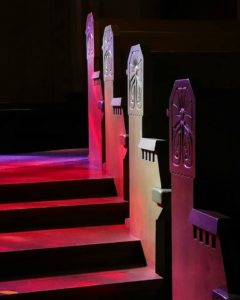Tampere Cathedral
He is wounded. Or should I write: she is wounded. The sex is never assigned to these beings, especially in a cathedral. Not that it matters, after all: small blood drops stain his wings which rise from his lungs and hide some golden locks. A white cloth covers his eyes. I have all the time in the world to observe his delicate profile. His skin is as pure as the garment that he is wearing and as precious as the snowdrops that he is holding between his right hand and one of the sides of the stretcher. For a moment, I think I can smell their scent, and I pray that those flowers can alleviate his pain.
Then, I realise the greatness of this painting: it talks about the importance of the Others in our lives. Or at least that’s how I decide to interpret it: I decide that the essence of Hugo Simberg’s work is Love, the support that we receive from our neighbours in the time of need.
It often comes from those from whom we expect nothing, and so it does here: in the background, a Nordic bay, and then two unlikely Saviours, two very stern-looking children, wearing grow-ups’ clothes: Love comes from them. They comfort the Wounded Angel, they lift him towards some sort of care, they let him rest.
One of them doesn’t even look at me: he keeps on walking straight, in his black jacket. The other one stares straight into my eyes, into my heart: “What would you do if someone asks for help? What would you have done if you had found a Wounded Angel on your road?”. I don’t know what I’d do. I am not even sure that what I did in the past was the right thing to do or is worth mentioning. I am not sure I was as noble as you, my little friend, gazing at me from the walls of this unusual Finnish cathedral. I am just trying my best.
Above all, in a cathedral
Life is often associated with plants, in art. The Tree of Life. Plant the seeds and be patient. The Rose of the Little Prince. Etcetera etcetera. Death is tending these strange vegetables, here, instead: three skeletons are the gardeners in this nursery where no plant grows alone.
The first skeleton is pouring water from a watering can. And among all the bizarre objects of this painting, this is the one that stands out for me: in this unusual greenhouse – which would be unusual everywhere, but above all, in a cathedral – this watering can makes me smile because it stands for the beauty of Life. It’s ordinary, green, it’s similar to the one you have in your garden if you are lucky enough to have a garden. Life is made of ordinary things, and they are those that we miss the most once they are gone.
The second skeleton, in his cassock, is hugging a blue plant. It looks like he is trying to comfort this vegetable: all things must pass, and maybe also this greenhouse is nothing but a passage from this world to another one which are meant to understand yet. His bony hands carefully hold the plant to his muscle-less chest. Don’t worry, small plant. You are not alone, here.
I cannot see the third skeleton’s face. What is he doing, up there? Is he praying? Is he talking to the other otherworldly-looking plants? Is he looking at the roots of those trees whose fronds we cannot see? I think he is just curious, and he is gazing toward the small path which is starting in the middle of the painting:
“It was great,
The late summer is over,
It was great,
The shadows are lengthening beyond the evening,
Ask not where the road goes,
Just follow it and keep on walking”.
What!? In a cathedral??!
I follow an impalpable pathway among the chairs. I climb up the stairs that lead me upstairs: on this first floor, the cathedral becomes even more tempting. The view from here reminds me of a ballroom. The burgundy and purple light, pouring from the immense glass windows, cascades everywhere: it caresses – almost sensually – every object, the steps, the pipe organ, the believers’ benches. It touches my steps and it leads my gaze on, up, on to the ceiling.
 I expect a hieratic and benevolent bust up there, a Pantocrator Christ, the ruler of the universe. I could not be more wrong: up there, in the highest point of the cathedral, looking down to the congregation, there is a snake, with a big open mouth, holding that Apple in his fangs.
I expect a hieratic and benevolent bust up there, a Pantocrator Christ, the ruler of the universe. I could not be more wrong: up there, in the highest point of the cathedral, looking down to the congregation, there is a snake, with a big open mouth, holding that Apple in his fangs.
8 lamps light it up. Eight, the Infinity number.
It is twisting in a red background, as red as the Sin, as the Corruption.
As red as Love, without which we are nothing.




